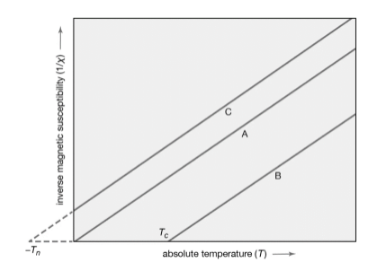Curie’s Law
The magnetization existing in a paramagnetic substance is said to be directly proportional to the applied magnetic field, according to Curie’s Law. When the object we examined is heated, the magnetization is considered as inversely proportional to the temperature. The law we’re talking about was discovered by Pierre Curie, a French scientist.
Faraday was the first to manipulate materials to make them diamagnetic or paramagnetic. As a result, he made this classification. His main interest in the force is how it affects the substances in an inhomogeneous magnetic field. The magnetization of a substance M is fairly linearly related to the strength of the applied field H at very low field strengths.

Formula of Curie’s Law
Mathematically, Curie’s Law can be expressed as:
M=C×B/T
M= magnetism
B= magnetic field (Tesla)
C= Curie’s Constant
T= Absolute temperature (Kelvin)
Magnetic Susceptibility
Magnetic susceptibility is a numerical measure of a material’s ability to be magnetised in response to a certain applied magnetic field. The ratio of the magnetization M within the material to the applied magnetic field strength H, or m=MH, is the magnetic susceptibility of a material, typically indicated by m . Because magnetization essentially entails a particular measure of magnetism (dipole moment) per unit volume, this ratio is called the volume susceptibility.
Magnetic Materials
On the basis of their susceptibilities, magnetic materials are classed as diamagnetic, paramagnetic, or ferromagnetic. When placed in a nonuniform magnetic field, diamagnetic materials, such as bismuth, partially expel the external field from within themselves and, if formed like a rod, line up at right angles. Constant, tiny negative susceptibilities characterise diamagnetic materials, which are only marginally impacted by temperature fluctuations.
Paramagnetic materials
Since their atoms have modest magnetic dipole moments that partially line up with the external field, paramagnetic materials such as platinum augment a magnetic field in which they are put. At ambient temperature, paramagnetic materials have continuous, tiny positive susceptibilities of less than 1/1000, implying that the magnetic field amplification generated by magnetic dipole alignment is small in comparison to the applied field. The value of absolute temperature has an inverse relationship with paramagnetic susceptibility. Increased temperature causes atoms to vibrate more, interfering with magnetic dipole alignment.
Ferromagnetic materials
Iron and cobalt are ferromagnetic materials with variable susceptibilities; their magnetization is not always proportional to the applied field strength. The positive values of measured ferromagnetic susceptibilities are often in excess of 1,000. Because ferromagnetic materials are made up of highly magnetised clusters of atomic magnets (ferromagnetic domains) that are more easily lined up by the external field, the magnetization within them can be 1,000 times more than the external magnetising field.
Curie Temperature
Curie’s temperature is the temperature at which ferromagnetic material becomes paramagnetic when heated. This type of transition, which we’re seeing here, is employed in optical storage media to erase old data and enter fresh data.
Paramagnetism and Diamagnetism
The paramagnetic magnet demonstrates a type of magnetism in which many objects are attracted to it by an externally produced magnetic field. Magnetic fields repel diamagnetic materials, which produce an induced magnetic field with the opposite magnetic direction as the applied magnetic field.
The majority of the elements covered thus far are chemical elements, as well as some compounds with a magnetic permeability greater than or equal to 1.
Magnetic Moment
The moment of a magnet induced by an applied field is proportional to the field’s strength or weakness. It is commonly stated that a sensitive analytical balance is required to identify the various modern measurements and effects on the paramagnetic substance. A SQUID magnetometer is frequently used for this.
Permeability
It is determined by a material’s ability to create a magnetic field within itself or to get magnetised when exposed to one. Permeability is also known as the magnetic constant.
Curie point
Above a certain temperature, materials lose their magnetic characteristics. At this temperature, the characteristics of several materials change dramatically.
Curie constant
It is a material attribute that ties a substance’s magnetic capacity to its temperature. It’s a material dependency property that uses Curie’s law to link the magnetic susceptibility of a material to its temperature.
Conclusion
The majority of elements, as well as some compounds, are naturally paramagnetic. Paramagnetism is a property of compounds such as palladium, iron, platinum, and the earth’s rare elements. In these compounds, which are made up of atoms of various elements, some inner shell electrons are defective. As a result, their unpaired electrons spin like orbits and tops like satellites. The atoms become magnetic as a result, aligning with and strengthening a magnetic field.
 Profile
Profile Settings
Settings Refer your friends
Refer your friends Sign out
Sign out




